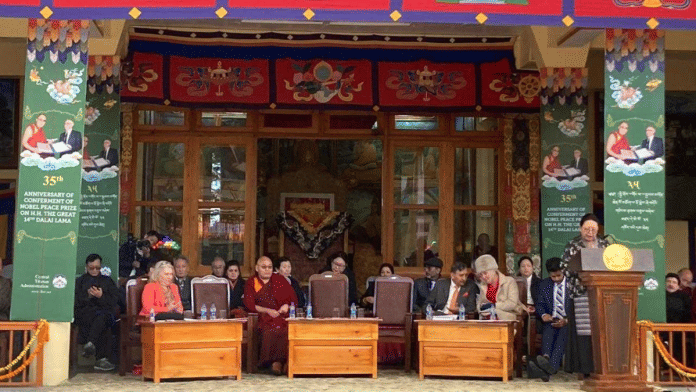Dharamshala: For peace on the border between India and China, New Delhi must broach the subject of Tibet with Beijing, said Dolma Gyari, the officiating sikyong (president) of the Central Tibetan Administration (CTA) here in Dharamshala Wednesday.
She also reiterated the CTA’s stance that Arunachal Pradesh is an integral part of India.
“If India is to have peace in its borders with China, it should broach the subject of historic Tibet with Beijing. It is Tibet that is a signatory to the Simla Convention, that defines the boundaries of India. The Central Tibetan Administration believes that Arunachal Pradesh and any other territories disputed by China are inseparable and integral parts of India,” said Gyari, the minister of the Department of Security in the CTA.
In an interaction with media personnel, the officiating sikyong welcomed the recent thaw in ties between India and China and said that peace and harmony between the two countries would always be welcomed by the CTA.
She made these remarks before the start of the official celebrations marking 35 years of the Nobel Peace Prize being conferred upon the Dalai Lama.
“The Sino-Tibet conflict must be resolved for peace on the borders of India and China” added Gyari.
Gyari is currently serving as officiating or acting sikyong, filling in for Sikyong Penpa Tseringor—the democratically elected head of CTA—who is currently on an official trip to the US.
The CTA was set up by the Dalai Lama to govern the Tibetans living in exile, following his arrival in India in March 1959. He had fled Lhasa after the Chinese government quelled the 1959 Tibetan uprising. Headquartered in McLeod Ganj, the CTA or administration in exile has a functional executive, legislative, and judiciary to look after the nearly 1,50,000 exiled Tibetans scattered across roughly 130 countries across the globe.
India and China have a long-standing dispute over the demarcation of borders, with New Delhi maintaining the validity of the Simla Convention, an agreement signed in 1914 by the then British Raj and Tibet. It was during this convention that the McMahon Line came into being. China, which sent a delegation to the convention, was not signatory to the final document.
In 2020, clashes between the Indian and Chinese armed forces broke out in Galwan, followed by a period of heightened diplomatic tensions between the two countries. After over four years of negotiations, on 21 October 2024, India announced that the two countries had reached an agreement to disengage in Ladakh.
Since then, the Indian armed forces have completed verification patrols in the region, while at the political level, Prime Minister Narendra Modi held a bilateral meeting with Chinese President Xi Jinping on the sidelines of the BRICS summit in the Russian city of Kazan on 24 October. External Affairs Minister S. Jaishankar met with his counterpart Wang Yi the following month on the margins of the G20 summit in Brazil.
A meeting between the special representatives of India and China on the border question— National Security Adviser Ajit Doval and foreign minister Wang—is expected to happen sometime “soon”, according to the Ministry of External Affairs (MEA), possibly even at the end of this month.
Also read: Modi-Xi handshake boosted ‘5 Ds’ in Eastern Ladakh. The biggest D is the toughest
India’s position on Tibet
India has consistently welcomed Tibetan refugees into the country while maintaining economic ties with China. Both the administrative unit—the CTA—and the Dalai Lama, the spiritual leader of the Tibetan people, function out of Dharamshala in Himachal Pradesh.
India has on multiple occasions reiterated recognition of Tibet’s autonomy.
In 1988, then prime minister Rajiv Gandhi, during a visit to China—the first by an Indian prime minister in over three decades—reiterated that Tibet was an autonomous region in the Asian country.
The 2003 Declaration on Principles for Relations and Comprehensive Cooperation between the Republic of India and the People’s Republic of China, announced during prime minister Atal Bihari Vajpayee’s visit to China, saw New Delhi “recognising” Tibet as a “territory” of the Asian country and followed Gandhi’s formulation of not allowing Tibetans to engage in anti-China activities from India.
While New Delhi has maintained its position on Tibet for decades now, the CTA hopes that the subject being broached between the two countries will start the process which would eventually see meaningful autonomy for Tibet and for the exiles to return home.
The CTA and the Dalai Lama do not seek independence for Tibet from China. However, they wish for “meaningful autonomy” in the areas of education, culture, religion, and the environment. This position is known as the ‘Middle Way‘.
This reporter was in Dharamshala at the invitation of the India – Tibet Coordination Office (ITCO).
(Edited by Shivani Mago)






